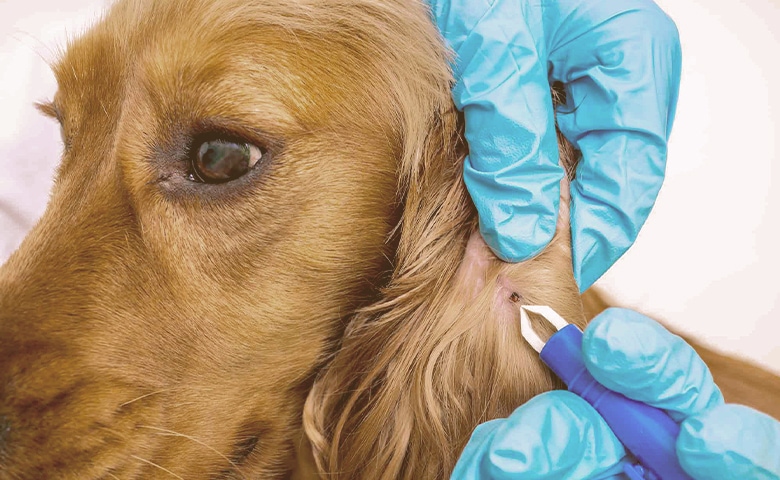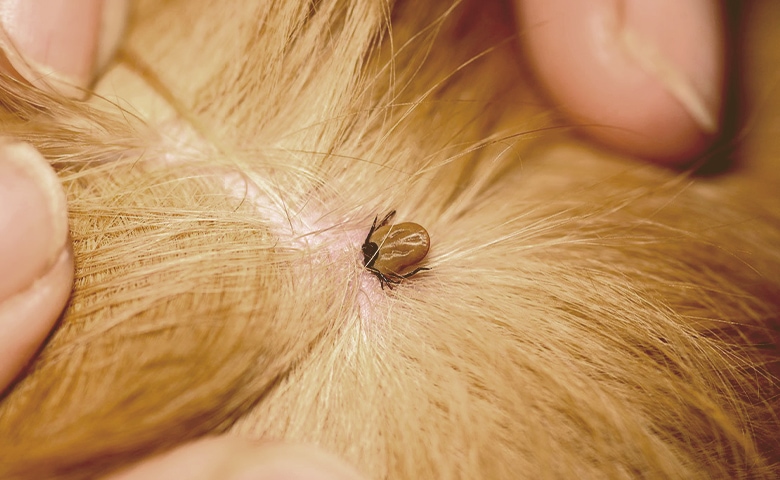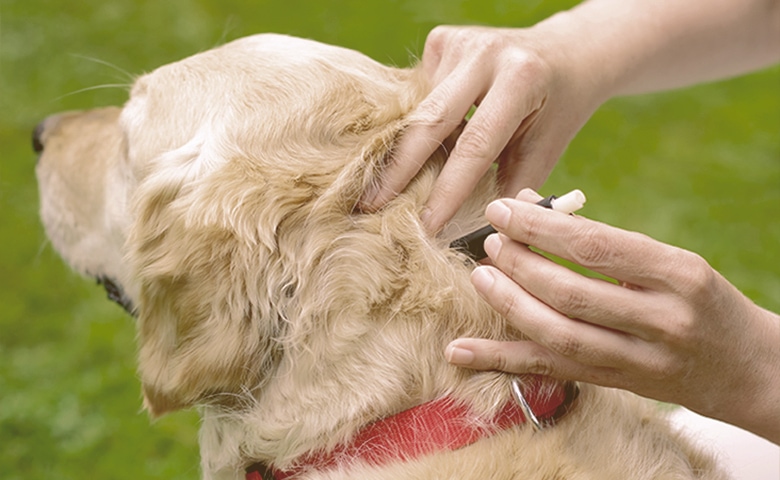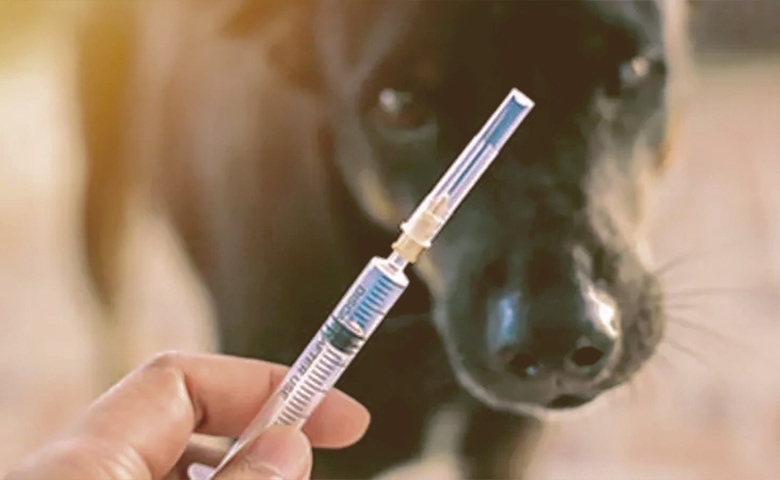
What to Do if Your Dog Tests Positive for Lyme Disease
Alex Vicente • Updated on August 2, 2023
- This review contains affiliate links. Read more here.
- Not a substitute for professional veterinary help.
If you find out your dog has been diagnosed with Lyme disease, it can be frightening if you don’t know much about the disease.
The good news is that just because a dog tests positive for Lyme disease doesn’t mean that they have a bad chance of recovering.
Dogs should be treated with antibiotics if they test positive for Lyme disease.
Many dogs may test positive for Lyme disease without showing any symptoms if they’ve been exposed. Some dogs may contract serious symptoms.
Lyme disease is preventable by controlling a dog’s exposure to infected ticks.
Even if your dog isn’t showing Lyme disease symptoms, a positive test means they could potentially develop symptoms in the future.
Read on to learn more about how Lyme disease presents in dogs and what you can do to keep your dog safe from it.
Table of Contents
The Cause of Lyme Disease in Dogs

Lyme disease is a bacterial infection caused by bacteria transmitted through tick bites. This disease can be caused by four main types of bacteria. These are the types of bacteria that cause Lyme disease:
- Borrelia burgdorferi
- Borrelia mayonii
- Borrelia afzelii
- Borrelia garinii
Lyme disease is the most common tick-transmitted disease that affects both dogs and humans. Ticks transmit this disease to people and dogs when they bite them to suck their blood, allowing the infection to enter the person’s bloodstream as they do so.
Treating Canine Lyme Disease
Luckily, Lyme disease is relatively easy to treat in dogs with a course of antibiotics if it is caught early.
A few of the major challenges of Lyme disease in both dogs and humans are that the symptoms of this disease often mimic the symptoms of other illnesses. This makes Lyme disease harder to diagnose without running bloodwork. Another barrier to diagnosis is that the disease itself may not exhibit symptoms for days or even weeks after exposure to the infected tick.
This makes it much harder for physicians to put two and two together to diagnose the illness as Lyme disease. The good news is that the treatment of Lyme disease is pretty straightforward. However, you don’t want to let the disease progress without treatment since it can ultimately affect the kidneys and can potentially cause lasting chronic damage.
What Are Ticks?

Ticks are a small parasitic insect that eats by latching onto an animal and sucking their blood through a hole the insect punctures in the skin. Ticks are known for the characteristic way that their bodies become bloated with blood during feeding.
The ticks that are most often responsible for transmitting Lyme disease are a species known as Ixodes scapularis, or the black-legged deer tick. In some areas, this tick is also known as a bear tick.
Many ticks are so small when they’re not full of blood that it can be difficult to detect them before they’ve had a chance to bite you or your dog. Since being bitten by a tick puts you at risk of Lyme disease no matter how long the tick feeds on you, it’s important to practice tick prevention before your dog has had a chance to get bitten.
Where Do Dogs Encounter Ticks?
The black-legged deer tick often latches on to passing dogs when they’re hiking around in woody or forested areas. It is also found in high grass. Even if your dog never leaves the yard, squirrels and other encroaching wildlife infested with ticks can bring these disease-bearing insects onto the property.
How to Treat Dogs for Ticks
Since any tick bite carries the risk of Lyme disease, the best preventative treatment to take to prevent the disease is to keep dogs on a monthly tick preventative medicine. This oral medicine is taken once a month and helps provide protection for dogs against ticks.
The other measure you can take against ticks is to check dogs thoroughly for ticks after every hike through the woods and fields, or at least once a week otherwise. It’s important to search the dog thoroughly since ticks are small and hide themselves away in nooks and crannies. Here are a few places you should look in particular to find Lyme-bearing ticks on your dog:
- Between their toes
- In the groin area where the groin meets the leg
- In the fold between the dog’s leg and its chest (the “armpit”)
For longer-haired dogs, brushing the dog with a comb as you inspect them for ticks can help you part their hair and make tick inspections less difficult. It’s important to inspect both yourself and your dog each time you leave a wooded area to prevent the spread of Lyme disease.
How to Remove a Tick from Your Dog

If you do happen to find a tick on your dog, removing it quickly is the best way to prevent your dog from contracting Lyme disease through a bite. If you’re lucky, you can remove the tick before it has a chance to latch on. Even if the tick has already attached itself to your dog, removing it quickly and removing the entire tick can help reduce exposure to disease.
Here’s the proper procedure for removing a tick from your dog:
- Use a pair of tweezers to remove the tick from your dog’s skin. If the tick hasn’t attached itself to your dog yet, then plucking the tick off should be relatively simple.
- Once you’ve removed the tick, drop it in a jar of rubbing alcohol to kill it. Note that ticks are very resilient and difficult to kill by just smashing them. You also don’t want to come into direct contact with the tick if you can help it.
- If the tick has already buried itself in the skin of your dog, twist the tick carefully to force it to detach itself. You can also hold a cotton ball dipped in rubbing alcohol to the entire tick and this should kill it. The goal is to avoid leaving the head of the tick buried in the dog’s skin. This can cause infection and increase the chances of a Lyme contraction.
- After the tick has been removed, treat the dog’s skin with a topical antibiotic to prevent infection. If it bit your dog, the tick should be saved in a plastic bag in the freezer so that it can be tested if your dog develops any symptoms that may correlate with Lyme disease or other tick-borne illness.
Keep in mind that ticks can be difficult to find, especially on dogs that are dark-colored or dogs with long hair. Regular baths in flea and tick shampoo can help destroy any ticks you don’t manage to find on your inspections, and a tick collar can help kill ticks on contact around the head and neck. This is useful since ticks especially like attaching around a dog’s ears.
When you’re done inspecting your dog for ticks and removing them, don’t forget to do a tick inspection on yourself too. The effects of Lyme disease are even more serious in humans than they are in dogs.
Symptoms of Lyme Disease in Dogs

The symptoms of Lyme disease can vary from dog to dog, and can also vary in severity from mild to chronic and debilitating. Here are a few of the symptoms of Lyme disease you might see if your dog tests positive:
- Fever: Dogs that contract Lyme disease will often run an intermittent fever between 103-105 degrees Fahrenheit. Since this is a relatively low-grade fever for a dog, it may be difficult to identify without other symptoms.
- Lameness and joint pain: Another intermittent symptom that occurs in a Lyme infection is limping and lameness. This happens as the result of joint pain and inflammation caused by the Lyme infection.
- Inflammation and swelling: Lyme is a bacterial infection, and this often causes an inflammatory response in the dog’s immune system as it tries to resist the disease.
- Fatigue: Fatigue is often one of the more noticeable symptoms a dog will exhibit that will lead them to be tested for Lyme disease. If your dog seems extra tired and lacking in energy, a Lyme disease test may be a good idea.
- Loss of appetite: Another obvious symptom of Lyme disease in dogs is loss of appetite. Since many dogs have a hearty appetite, this is usually one of the easier symptoms for owners to spot at home when their dog becomes ill.
- Depression: Along with general fatigue, a Lyme-affected dog may seem depressed or unaffected by positive activities that usually excite them. Like loss of appetite and fatigue, depression is an early warning sign that can be hard to spot if you’re not looking.
- Reduced Kidney Function: Reduced kidney function isn’t usually an obvious symptom of Lyme disease, but it can be one of the more serious and dangerous symptoms. Once kidney damage is done by Lyme, it is usually irreversible.
Many dogs may not ever get tested for Lyme disease until they are showing symptoms. By this point, the infection may cause lasting organ damage or recurrent joint problems.
How Do Vets Test for Lyme Disease?
Vets typically test for Lyme disease using a series of bloodwork known as the SNAP test. These blood tests also test for heartworms, ehrlichiosis, and anaplasmosis. The cost of this blood work varies widely from veterinarian to veterinarian, so be sure to discuss the costs before you agree to run any tests.
Asymptomatic Lyme Disease

While 90% of the people who contract Lyme disease from a tick bite will show obvious symptoms of the disease, this percentage drops drastically in dogs. Only 5-15% of dogs who contract Lyme disease will show symptoms. This means there are many dogs walking around who are positive for Lyme disease that don’t show any signs of having it.
If your dog lives in a wooded or rural area, this can increase their exposure to asymptomatic and symptomatic Lyme disease. When your dog spends a lot of time in the forest, they may contract Lyme disease without their owner ever knowing that they caught it if they catch an asymptomatic form of the disease.
Another disadvantage of not checking dogs for ticks regardless of whether they develop Lyme symptoms or not is that dogs can easily carry Lyme-bearing ticks into your home where they can infect humans. While only a minority of dogs end up showing symptoms of Lyme disease, there is a much higher percentage of humans contracting it that end up seriously ill.
Can Dogs Pass Lyme Disease to People?
Regardless of whether your dog has symptomatic or asymptomatic Lyme disease, there is no chance that your dog can pass Lyme disease directly to you if they test positive for it. You can only contract Lyme disease yourself if you’re bitten by an infected tick.
Treatment for Lyme Disease in Dogs

While treatment for Lyme disease in dogs is a straightforward course of antibiotics, Lyme disease requires a long form of treatment. This means that if they test positive, your dog will have to undergo Lyme treatment for up to four weeks before they’re cleared of the infection.
There are two major forms of antibiotics used to treat Lyme disease in dogs:
- Doxycycline
- Tetracycline
These two broad spectrum antibiotics are used to treat a wide range of illnesses. It’s important to remember that whenever your dog is prescribed antibiotics, the antibiotics should be used until the medicine is gone even if the dog shows signs of improvement before that. This helps the antibiotics to drive out every last bit of the infection and prevents a resurgence later.
Is It Possible for Dogs to be Reinfected?
Since Lyme disease is a bacterial infection, it’s possible for a dog to re-contract Lyme disease from another infected tick after being treated for it for a previous infection. Even if a dog has contracted Lyme disease in the past, this does not protect them from being infected in the future. This is why preventing infected ticks from biting your dog is so important.
Treating Asymptomatic Lyme Disease in Dogs
If your dog has tested positive for Lyme disease and isn’t showing any symptoms, you may be wondering why you need to treat them for the disease. After all, if your dog can’t give you Lyme disease and they aren’t showing any signs of having it, why treat them?
The answer is in how Lyme disease attacks the body. Even if the dog isn’t currently showing symptoms of Lyme disease, that doesn’t mean they won’t eventually start developing symptoms. And if Lyme disease is allowed to ravage the body unchecked, the symptoms that eventually show up can be worse than any mild obvious symptoms, such as kidney damage.
Preventing Lyme Disease in Dogs

Since Lyme disease can cause irreversible damage before it’s detected, and it can be spread by tick bites even if you give your dog a tick preventative, it’s a good idea to try and prevent your dog from catching Lyme disease to begin with.
While you can’t keep your dog from getting ticks on them in the same way you can protect yourself in the woods through long sleeves and long pants, it’s hard to give your dog the same protection. It’s very easy for ticks to hop onto your dog from the surrounding grass and bury themselves in your dog’s fur.
Preventing Lyme disease in dogs involves checking them regularly for tick infestation and doing a thorough inspection for ticks on your dog after any tromp through areas which might be invested with ticks, such as a wooded hiking trail. It takes ticks a little while to settle in and bite the dog, so you have a chance to catch them and pick them off before they latch on if you look.
Here are some tips that you can use to help prevent your dog from getting ticks:
- Do a tick check after every hike. Dogs are most likely to pick up ticks in rural or wooded areas, so if you’re going hiking with your dog be sure to check them over for ticks when you’re done. You should also do a thorough inspection on yourself as well.
- Use a tick collar. Tick collars contain a mild pesticide that is deadly to ticks but will not harm your dog. Tick collars can kill ticks before the ticks have a chance to bite.
- Keep your grass mowed short. Ticks love tall grass, so if you want to keep them out of your yard, make sure to keep your lawn tidy and short.
Staying vigilant against ticks is a big part of preventing Lyme disease in both your dog and yourself.
Lyme Disease in Dogs Can Be Serious

A dog that tests positive for Lyme disease can be easily treated, but the damage that occurs before diagnosis occurs is preventable if you can keep your dog from being bitten by ticks to begin with. Between checking them after walking in risky areas to keeping a tick deterrent on them, there are plenty of methods for making sure Lyme-infected ticks stay off your furry friend.
Sources
Mayo Clinic – Lyme disease
PetMD – Lyme Disease in Dogs
VetStreet – Testing in Dogs


